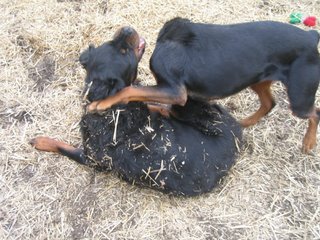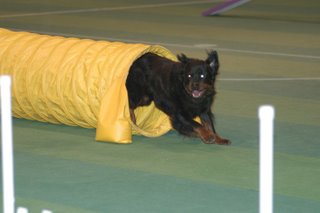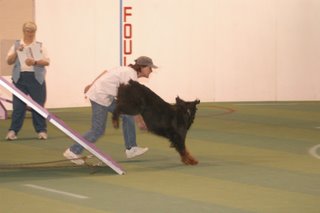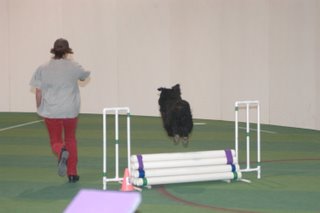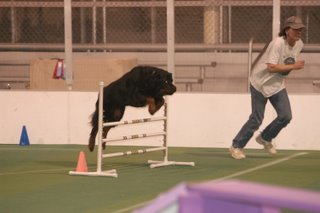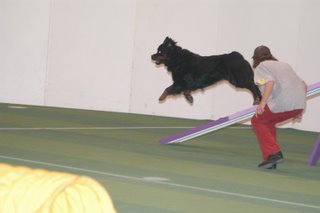Animal rights groups have pushed for bans on "cosmetic" surgeries like ear cropping & tail docking - in fact these procedures are banned outright in some countries. Don't kid yourself that it can't happen here in the US. So. What does Auntie Carina think? Auntie Carina thinks it's fine.
Ear crops & tail docks. Tail docking is done when a pup is just a few days old. Puppies have little feeling in their south ends at that age - neurological development is incomplete, which is why they can't control pooping and peeing yet. I've been told by a Rottweiler breeder and vets that tiny pups simply don't notice it. They squeak when they're being picked up and handled, but pay no attention to the snip.
Complications from this are practically nonexistent. I can't think of a single reason why not to do it on breeds traditionally docked. I've heard three reasons why not. A: It's cruel. No, it's not. B: It takes away a dog's ability to "signal" other dogs with tail position. Well, dogs' entire bodies are involved in communicating with other dogs; nothing I've ever heard or experienced validates this theory. Dogs are savvy enough to read the whole picture without being confused about the absence of tail position. C: Dogs use their tails for balance and agility. Oh baloney, that's just silly.
Why do it? Because we can, and it's harmless. When they wind up in shelters and rescues (which happens by the thousands every day), undocked dogs get passed by which is often a death sentence. Because it looks cool. It's one less body part to be injured - dogs with long whippy tails frequently break or bruise them. I had a dog who lost a third of her tail in an unfortunate incident involving a thunderstorm and a broken double hung window. The vet cleaned up the wound and stitched it up fine, and she had a funny-looking tail for a GSD mix, but she didn't seem to mind.
Ear cropping is no doubt more bothersome and uncomfortable for a dog, because it's done when they're a bit older. Crating a dog is bothersome and uncomfortable for them too.
Debarking. This one is controversial because complications are more common. From everything I've read, and from a recent conversation with a Sheltie person, the skill and experience of the vet is critical. There's several different procedures and finding an experienced vet who uses laser surgery to nick the vocal chords leads to a happy, successful outcome.
Here's an excellent,
common sense little article on debarking. Read it.
Now, debarking really should be a last resort. In many cases it's not difficult to train a dog to vocalize appropriately. Most dogs are communicating a range of "messages" by barking. Telling his pack there's someone at the door, excitement, play barking, warning barking, boredom, demanding attention, to go out or come back in. Why nag a dog to shut up when she's just telling you someone's at the door? She's just being a watchdog; this is a good thing. If she continues to yap incessantly once the visitor enters the house, she's saying something quite different - could be defensive, excitement or demanding attention. Training a dog to limit her barking to appropriate or natural situations isn't that difficult; not to do so is owner laziness.
We're the ones with great big complex brains. Dogs have little, simple brains. Figure it out.
If she's barking because she's stuck out by herself, tied up outside all the time, that's easy. Don't leave the poor thing chained up and isolated. That's terribly cruel. I think people who have chained up outside dogs should be chained up outside by themselves for a year and see how they like it. I really do.
However. Sometimes, with some dogs, it's just difficult to almost impossible to train them to be quiet, say when we're at work and they're home alone. Try everything else first. You can even try those nasty no-bark shock collars, or the ones that squirt lemon juice in their faces every time they make a noise. Personally, I think that's mean but it's fairly widely accepted. in extreme cases, why not have a simple surgery done? She can still bark all she wants, you don't have to nag her, your neighbors will be happier and you won't be threatened with eviction. The only difference is her bark will be much, much quieter.
We routinely do speuters on dogs and cats for our own convenience, why not this?
Spaying and neutering. This one's tough. Apparently, a huge percentage of the population either doesn't care that their pets spit out litter after litter, contributing to massive overpopulation and Dumpsters full of throw-away dead pets in every city in the US, every day. Or, they are too stupid and irresponsible to figure out how to prevent boy animals and girl animals hooking up. If I ran a shelter or rescue organization, I would mandate speuter for every animal that leaves alive, you bet.
However. Tens of thousands of people manage to keep intact dogs their entire lives without a single unplanned or throw-away litter.
Tens of thousands more wait until the dog has reached sexual maturity before speutering. For responsible owners, I think this makes sense.
Why? There's lots of health reasons, for one thing. Nature intended for animals to be intact and retain all the hormones. Hormones are important to human health, right? Same with dogs. Spayed bitches often become incontinent - actually referred to as
spay incontinence - and have more urinary tract infections. True, this isn't life threatening, but it can be painful and inconvenient. By waiting until she is about a year old, the risk can be minimised. Some cancers, heart problems and thyroid problems have been found significantly higher in speutered dogs.
Male dogs - especially in breeds prone to bone cancer - have significantly
higher rates of osteosarcoma when neutered.The (extremely knowlegable and ethical) breeder I got Cooper from advised me to wait until 18 months before neutering because of osteo risks. That was in 2001, before the above study was published - people were already aware of the risk. Dogs can get osteo as young as two years old, and it is often terminal and
very common in Rottweilers, Boxers and several other breeds. I lost my last Rottie (neutered at 6 months) to osteo. A good friend lost hers at about the same time, an early-spayed bitch. My first Rottweiler developed lymphatic cancer when he was about two - the vet was able to remove all the cancerous tissue, although the dog tragically died less than two years later from unrelated causes. (I know, anecdotes aren't proof.)
Here's a
sensible article, with references, on the downsides of early and pediatric speutering.
We surgically alter our dogs' behaviour to make them "easier to train" by speutering. We stick them in cages, confine them to fenced yards and prevent them from running or moving in their natural gait by putting a collar and leash on them for walks. If we walk them at all, which most people don't. We bathe them, feed them pellets instead of real food and train them to conform to our wishes. We make them endure grooming and
stripping (which involves yanking all the outer hair out by the roots.) We clip their nails and clean their ears. We've intentionally bred dogs who cannot breathe or breed properly, like French and English Bulldogs. (They usually need a C-section to deliver because the puppies' heads are too big to fit through the pelvic opening.) We overmedicate and overvaccinate them - which leads to many deaths and health problems, by the way.
Tell me how debarking, ear cropping and tail docking is any more injurious or "unatural" for a dog, again?
